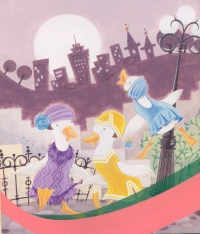| ________________
CM . . .
. Volume XIV Number 2 . . . . September 14, 2007
excerpt:
A companion volume to the Swanson and Spencer 2006 collaboration, A Crash of Rhinos, A Party of Jays, which focused on the collective names given to various animal groupings, the pair’s newest offering, Cheetah Cubs and Beetle Grubs, as explained by the subtitle The Wacky Ways We Name Young Animals, revolves about the names given to the offspring of 11 critters, the author’s use of “animal” being broadly interpreted. Specifically, youngsters will find the names of the young of: mountain goats, house mice, mackerel, mosquitoes, ducks, cheetahs, beetles, pigeons, eels, skunks and salmon.
Like the earlier volume, each entry occupies a pair of facing pages with one being used for the two parts of the brief text. One text portion provides an “explanation” for the name given to the specific young, and the second part, labeled “Neat to know,” offers three interesting facts about the young. The same page also contains a circle shaped colour photo of the appropriate young “animal.” The remaining page consists of Spencer’s literally interpreted full-colour illustration of the young. Consequently, the mice young, aka “pinkies,” replete with ears, eyes, nose, mouth and “arms,” become the fourth fingers on human hands. Two very small quibbles: The explanation around duck young being called flappers makes a comparison to “flappers of the 1920s– young women who spent lots of energy dancing....” Given the book’s intended audience, this reference to the long ago is likely wasted on them. With regard to cheetahs, youngsters read, “Young cheetahs are cubs.” Like Cub Scouts, they learn outdoor skills from grown-ups.” Spencer’s accompanying illustration reflects the economic realities of Canadian publishing and the need to penetrate the American market for it shows the cheetah cubs decked out in American Cub Scout uniforms, not those of Canada’s Wolf Cubs. Highly Recommended. After more than three decades of teaching courses in children’s and YA literature in the Faculty of Education at the University of Manitoba, Dave Jenkinson, himself once a Wolf Cub, can now focus on just being CM’s editor.
To comment on this
title or this review, send mail to cm@umanitoba.ca.
Copyright © the Manitoba Library Association. Reproduction for personal
use is permitted only if this copyright notice is maintained. Any
other reproduction is prohibited without permission.
NEXT REVIEW |TABLE OF CONTENTS FOR THIS ISSUE
- September 14, 2007. AUTHORS
| TITLES | MEDIA REVIEWS
| PROFILES
| BACK ISSUES
| SEARCH | CMARCHIVE
| HOME |

